10.05.2018
NASA Langley delivers on entry, descent, landing for InSight Mars mission
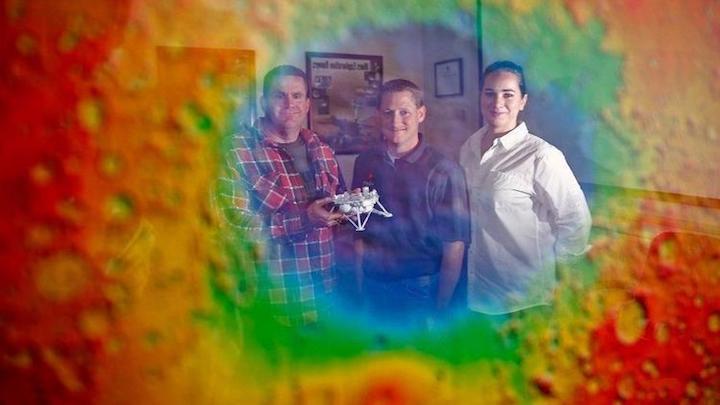
Ever since Neil Armstrong first set foot on the moon nearly half a century ago, whenever NASA wants to land something safely on another planet or lunar surface, it turns to Langley Research Center.
Saturday’s launch of the InSight lander bound for Mars is no exception.
Its two-year mission: to generate the first map of the interior of the red planet — if its science instruments can land on the surface in good working order.
But when it comes to the tricky process known as entry, descent and landing, or EDL, NASA Langley has always had the right stuff. In fact, Langley engineers and scientists were the first to put landers safely on the Martian surface back in the 1970s. And, in 2012, they finessed the landing of the Curiosity science rover — to date, the heaviest payload ever to land on Mars.
“We’re NASA’s EDL center,” said Robert Maddock, leader of the InSight EDL team at the Hampton research center. “We’re involved in things beyond Mars — Titan probes and Venus probes and anything that has to fly through an atmosphere and get to the ground.”
InSight stands for Interior Exploration Using Seismic Investigations, Geodesy and Heat Transport. And its mission is unique, going beyond where others have gone before.
“We’ve spent a lot of time with landers looking at the surface and orbiters looking at the atmosphere and the surface,” said Maddock. “But this is really going to be the first time we’re going to look deep into Mars’ surface. To understand more the geology, what’s going on inside.”
Such knowledge can inform our understanding of how other rocky bodies, including our own Earth and moon, formed and evolved over time, and where they may be headed.
InSight can also help identify subsurface resources, or perhaps even subsurface dangers, for any potential human colonists.
The lander is set to deploy a blazingly sensitive seismometer to gather new data on the sound waves generated by marsquakes and meteor strikes. Those waves will be used to craft a sonogram of sorts of Mars’ interior.
InSight also will deploy a thermal probe known as the “mole” to dig 3 to 5 meters under the surface and sniff out what lies there. Temperature measurements it takes along the way will offer key information about the planet’s core and how it stores and releases energy.
First, though, InSight must travel 300 million miles through the solar system before arriving at its destination in late November. All the while, Lockheed Martin, which built the spacecraft for NASA, will carefully monitor its health.
Maddock and his team will measure such crucial data against thousands upon thousands of computer simulations they ran over several years as they dreamed up countless potential landing scenarios to help design the best possible spacecraft and landing system.
During the journey, as data comes in, they’ll have many more opportunities to make any necessary tweaks to the flight software.
“We will update things as we become smarter along the way,” Maddock said. “And we will continually do these evaluations all the way up through a couple hours before landing.”
Still, said flight dynamics engineer Carlie Zumwalt, it’s impossible to know in advance the precise environment and conditions the craft will encounter as it lands.
Mars, for instance, has notoriously unpredictable weather.
“They have these gigantic dust storms that can roll in and roll out, kind of on a whim,” Zumwalt said. “We’re going to land seven months from now, (but) we have to design our system for an atmosphere and environment that we can’t predict seven months in the future.”
Traveling along with InSight will be the first CubeSats ever launched into interplanetary space. The small satellites will be used to test new communications technologies to relay information between InSight and Earth, especially as the craft lands, said flight dynamics engineer Daniel Litton.
Finally, around 3 p.m. on Nov. 26, InSight is scheduled to set down in a place called Elysium Planitia, a massive, flat plain, empty enough to offer a safe landing site.
Still, it’s always tricky landing payload on Mars because the planet’s thin atmosphere offers little purchase for a parachute to slow a spacecraft down from blistering entry speeds.
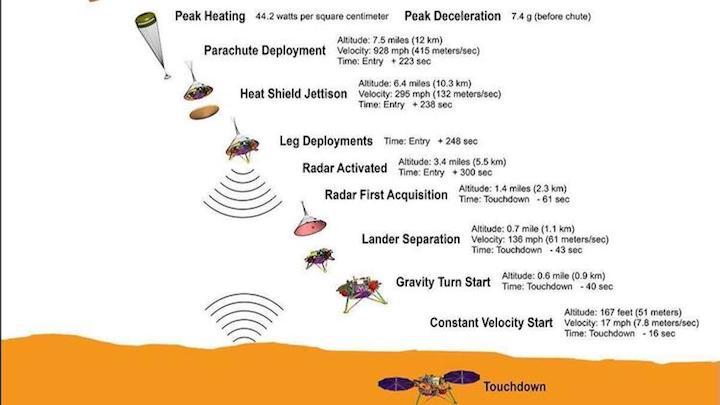
This NASA graphic shows the entry, descent and landing sequence for the InSight lander, just launched to Mars to map its interior for the first time.- Original Credit: NASA Langley Research Center- Original Source: NASA (/ HANDOUT)
-
According to NASA, entry will begin about 80 miles above the Martian surface, at a speed of 13,200 mph.
About 3 1/2 minutes later, at 7.5 miles above the surface and roaring along at 928 mph, the spacecraft’s parachute will deploy.
Seconds later, the craft will jettison its heat shield, deploy its landing legs and fire up its thrusters.
About half a mile above the surface, zipping down at 136 mph, the lander will separate as its thrusters carry it to what NASA hopes will be a safe touchdown.
Maddock says he’s “very confident” that InSight will nail its landing because the craft is essentially a version of the earlier Phoenix Mars lander, albeit heavier and expected to enter at a higher elevation with a thinner atmosphere to help slow it down.
Even after the landing, he said, the team will reconstruct what actually happened in order to build better predictions and simulations in future.
After it’s settled, and for nearly two Earth years, NASA says, InSight is tasked to listen to the Martian heartbeat and probe its depths, helping humans build a more complete picture of the planet.
“As we continue to gain momentum in our work to send astronauts back to the moon and on to Mars,” NASA’s new administrator, Jim Bridenstine, said in a recent statement, “missions like InSight are going to prove invaluable.”
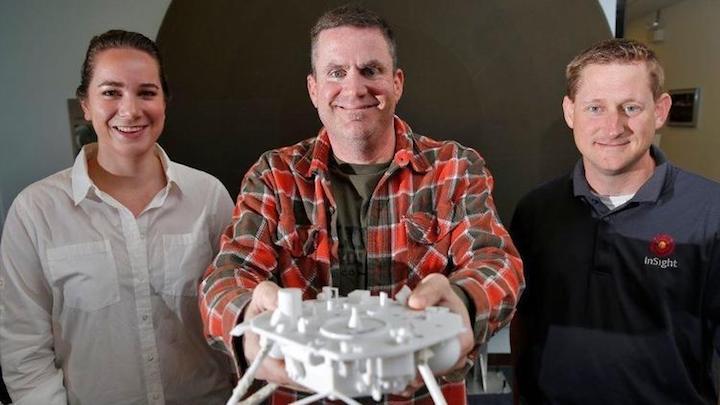
NASA Langley Research Center flight dynamics engineers Carlie Zumwalt, left, Robert Maddock, center, and Daniel Litton stand with a model replica of the InSight lander Tuesday morning. (Jonathon Gruenke / Daily Press)
Quelle: Daily Press
---
Update: 24.05.2018
.
InSight Steers Toward Mars

› Larger view
NASA's InSight lander has made its first course correction toward Mars.
InSight, short for Interior Exploration using Seismic Investigations, Geodesy and Heat Transport, is the first mission dedicated to exploring the deep interior of Mars.
The lander is currently encapsulated in a protective aeroshell, which launched on top of an Atlas V 401 rocket on May 5 from Vandenberg Air Force Base in Central California. Yesterday, the spacecraft fired its thrusters for the first time to change its flight path. This activity, called a trajectory correction maneuver, will happen a maximum of six times to guide the lander to Mars.
Every launch starts with a rocket. That's necessary to get a spacecraft out past Earth's gravity -- but rockets don't complete the journey to other planets. Before launch, every piece of hardware headed to Mars is cleaned, limiting the number of Earth microbes that might travel on the spacecraft. However, the rocket and its upper stage, called a Centaur, don't get the same special treatment.
As a result, Mars launches involve aiming the rocket just off-target so that it flies off into space. Separately, the spacecraft performs a series of trajectory correction maneuvers guiding it to the Red Planet. This makes sure that only the clean spacecraft lands on the planet, while the upper stage does not come close.
Precise calculations are required for InSight to arrive at exactly the right spot in Mars' atmosphere at exactly the right time, resulting in a landing on Nov. 26. Every step of the way, a team of navigators estimates the position and velocity of the spacecraft. Then they design maneuvers to deliver it to an entry point at Mars. That navigation team is based at NASA's Jet Propulsion Laboratory in Pasadena, California, which leads the InSight mission.
"This first maneuver is the largest we'll conduct," said Fernando Abilleira of JPL, InSight's Deputy Mission Design and Navigation Manager. "The thrusters will fire for about 40 seconds to impart a velocity change of 3.8 meters per second [8.5 mph] to the spacecraft. That will put us in the right ballpark as we aim for Mars."
Especially at the beginning of that cruise, navigators rely on NASA's Deep Space Network (DSN) to track the spacecraft. The DSN is a system of antennas located at three sites around the Earth. As the planet rotates, each of these sites comes into range of NASA's spacecraft, pinging them with radio signals to track their positions. The antennas also send and receive data this way.
The DSN can give very accurate measurements about spacecraft position and velocity. But predicting where InSight will be after it fires its thrusters requires lots of modeling, Abilleira said. As the cruise to Mars progresses, navigators have more information about the forces acting on a spacecraft. That lets them further refine their models. Combined with DSN tracking measurements, these models allow them to precisely drive the spacecraft to the desired entry point.
"Navigation is all about statistics, probability and uncertainty," Abilleira said. "As we gather more information on the forces acting on the spacecraft, we can better predict how it's moving and how future maneuvers will affect its path."
Yesterday's 40-second burn relies on four of eight thrusters on the spacecraft. A separate group of four is autonomously fired on a daily basis to keep the spacecraft's solar panels trained on the Sun and its antennas pointed at Earth. While necessary to maintain orientation, these small, daily firings also introduce errors that navigators have to account for and counterbalance.
"Everyone has been working hard since launch to assess what these small forces have done to the trajectory," said Allen Halsell of JPL, InSight's navigation team chief. "People have worked lots of hours to look at that. For engineers, it's a very interesting problem, and fun to try to figure out."
When the spacecraft is just a few hours from Mars, the planet's gravitational pull, or gravity well, will begin to reel the spacecraft in. At that point, InSight's team will prepare for the next milestone after cruise: entering Mars' atmosphere, descending to the surface and sticking InSight's landing.
JPL, a division of Caltech in Pasadena, California, manages InSight for NASA's Science Mission Directorate in Washington. InSight is part of NASA's Discovery Program, managed by the agency's Marshall Space Flight Center in Huntsville, Alabama. The InSight spacecraft, including cruise stage and lander, was built and tested by Lockheed Martin Space in Denver.
Quelle: NASA
---
Update: 26.05.2018
.
NASA's InSight Mars Lander Fires Up Its Engines in Space for 1st Time
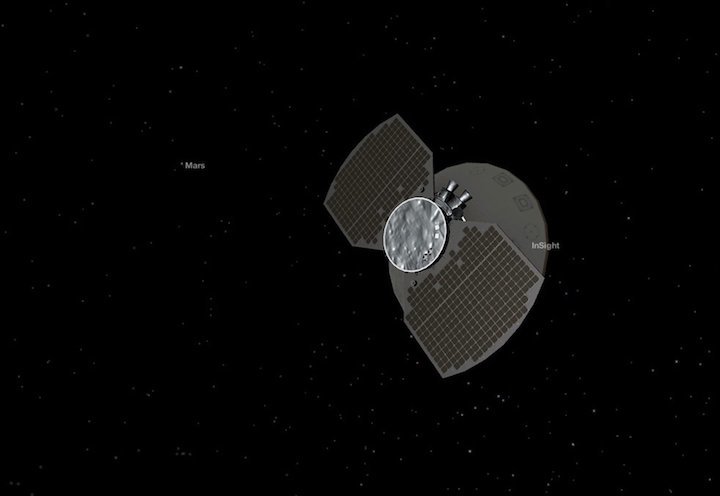
Artist's illustration of NASA's InSight lander cruising toward Mars. InSight, which launched May 5, performed its first course-correction maneuver on Tuesday (May 22).
-
NASA's InSight Mars lander performed its first engine burn on Tuesday (May 22), refining its course toward the Red Planet.
The 40-second burn, which involved four of InSight's eight thrusters, was designed to change the lander's velocity by about 8.5 mph (13.7 km/h). Mission team members will perform up to five additional burns before InSight's Nov. 26 touchdown, but none will be more substantial than Tuesday's, NASA officials said.
InSight didn't have Mars squarely in its sights when it lifted off atop a United Launch Alliance Atlas V rocket on May 5. That's perfectly normal; Mars spacecraft are scrubbed meticulously before liftoff to minimize the chances that they'll contaminate the Red Planet with Earth microbes, but the rockets they ride on remain "dirty."
"As a result, Mars launches involve aiming the rocket just off-target so that it flies off into space," NASA officials explained in a statement announcing InSight's engine burn. "Separately, the spacecraft performs a series of trajectory correction maneuvers guiding it to the Red Planet. This makes sure that only the clean spacecraft lands on the planet, while the [rocket] upper stage does not come close."
The four thrusters not involved in Tuesday's maneuver have been getting a workout, too. They fire autonomously every day to keep InSight's antenna facing Earth and its solar panels facing the sun, NASA officials said.
InSight's navigation team tracks these background burns closely.
"Everyone has been working hard since launch to assess what these small forces have done to the trajectory," InSight navigation team chief Allen Halsell, of NASA's Jet Propulsion Laboratory in Pasadena, California, said in the same statement. "People have worked lots of hours to look at that. For engineers, it's a very interesting problem, and fun to try to figure out."
InSight's next course-correction maneuver is scheduled to occur July 28, according to the mission's launch press kit. Additional burn dates are Oct. 12, Nov. 11, Nov. 18 and Nov. 25. (These dates may not be set in stone, however; according to the press kit, the first burn was originally supposed to take place on May 15.)
InSight — whose name is short for "Interior Exploration using Seismic Investigations, Geodesy and Heat Transport" — is headed for a flat plain just north of the Martian equator, where it will make a parachute-aided touchdown on Nov. 26.
The lander will then spend about two Earth years monitoring "marsquakes" and subsurface heat flow, gathering data that should reveal a great deal about the Red Planet's interior structure. InSight's observations will help scientists better understand how Mars, and rocky planets in general, form and evolve, mission team members have said.
InSight shared a launch with a demonstration mission called Mars Cube One& (MarCO), which consists of two identical, briefcase-size satellites. The MarCO craft have already traveled deeper into space than any other cubesat ever has.
If all goes according to plan, the duo will fly by Mars on Nov. 26 as InSight is performing its harrowing entry, descent and landing (EDL) sequence. The cubesats will attempt to beam InSight EDL telemetry back to Earth. (NASA's Mars Reconnaissance Orbiter will do this as well, so MarCO's contributions in this regard aren't critical to the InSight mission.)
Quelle: SC
---
Update: 21.08.2018
.
NASA's InSight Passes Halfway to Mars, Instruments Check In
NASA's InSight spacecraft, en route to a Nov. 26 landing on Mars, passed the halfway mark on Aug. 6. All of its instruments have been tested and are working well.
As of Aug. 20, the spacecraft had covered 172 million miles (277 million kilometers) since its launch 107 days ago. In another 98 days, it will travel another 129 million miles (208 million kilometers) and touch down in Mars' Elysium Planitia region, where it will be the first mission to study the Red Planet's deep interior. InSight stands for Interior Exploration using Seismic Investigations, Geodesy and Heat Transport.
The InSight team is using the time before the spacecraft's arrival at Mars to not only plan and practice for that critical day, but also to activate and check spacecraft subsystems vital to cruise, landing and surface operations, including the highly sensitive science instruments.
InSight's seismometer, which will be used to detect quakes on Mars, received a clean bill of health on July 19. The SEIS instrument (Seismic Experiment for Interior Structure) is a six-sensor seismometer combining two types of sensors to measure ground motions over a wide range of frequencies. It will give scientists a window into Mars' internal activity.
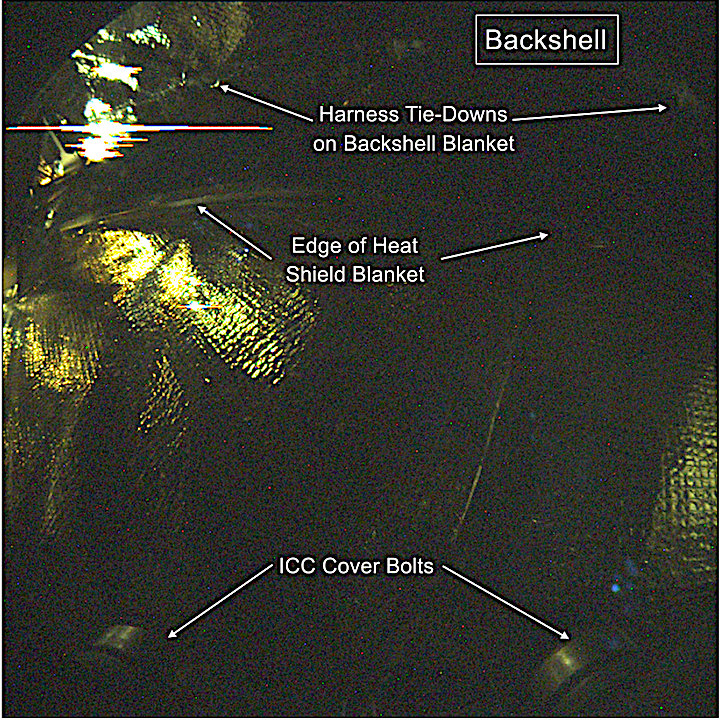
This long-exposure image (24 seconds) was taken by Instrument Context Camera (ICC) of NASA’s InSight Mars lander. The image shows some of the interior features of the backshell that encapsulates the spacecraft. The backshell carries the parachute and several components used during later stages of entry, descent, and landing. Along with the heatshield, the backshell protects NASA’s InSight Mars lander during its commute to and entry into the Martian atmosphere.
"We did our final performance checks on July 19, which were successful," said Bruce Banerdt, principal investigator of InSight from NASA's Jet Propulsion Laboratory, Pasadena, California.
The team also checked an instrument that will measure the amount of heat escaping from Mars. After being placed on the surface, InSight's Heat Flow and Physical Properties Package (HP3) instrument will use a self-hammering mechanical mole burrowing to a depth of 10 to 16 feet (3 to 5 meters). Measurements by sensors on the mole and on a science tether from the mole to the surface will yield the first precise determination of the amount of heat escaping from the planet's interior. The checkout consisted of powering on the main electronics for the instrument, performing checks of its instrument sensor elements, exercising some of the instrument's internal heaters, and reading out the stored settings in the electronics module.
The third of InSight's three main investigations -- Rotation and Interior Structure Experiment (RISE) -- uses the spacecraft's radio connection with Earth to assess perturbations of Mars' rotation axis. These measurements can provide information about the planet's core.
"We have been using the spacecraft's radio since launch day, and our conversations with InSight have been very cordial, so we are good to go with RISE as well," said Banerdt.
The lander's cameras checked out fine as well, taking a spacecraft selfie of the inside of the spacecraft's backshell. InSight Project Manager Tom Hoffman from JPL said that, "If you are an engineer on InSight, that first glimpse of the heat shield blanket, harness tie-downs and cover bolts is a very reassuring sight as it tells us our Instrument Context Camera is operating perfectly. The next picture we plan to take with this camera will be of the surface of Mars."
If all goes as planned, the camera will take the first image of Elysium Planitia minutes after InSight touches down on Mars.
JPL manages InSight for NASA's Science Mission Directorate. InSight is part of NASA's Discovery Program, managed by the agency's Marshall Space Flight Center in Huntsville, Alabama. The InSight spacecraft, including cruise stage and lander, was built and tested by Lockheed Martin Space in Denver.
A number of European partners, including France's Centre National d'Études Spatiales (CNES) and the German Aerospace Center (DLR), are supporting the InSight mission. CNES provided the Seismic Experiment for Interior Structure (SEIS) instrument, with significant contributions from the Max Planck Institute for Solar System Research (MPS) in Germany, the Swiss Institute of Technology (ETH) in Switzerland, Imperial College and Oxford University in the United Kingdom, and JPL. DLR provided the Heat Flow and Physical Properties Package (HP3) instrument.
NASA Invites Media to Cover InSight Mars Landing Activities at Jet Propulsion Laboratory
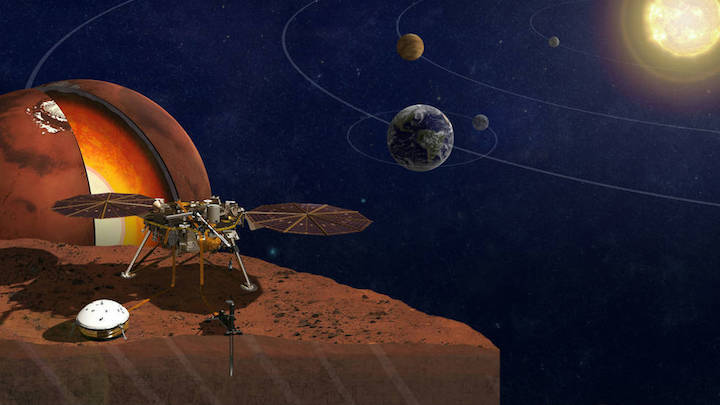
Media are invited to apply for credentials to cover activities at NASA’s Jet Propulsion Laboratory for the landing of the agency’s Interior Exploration using Seismic Investigations, Geodesy and Heat Transport (InSight) mission on Mars at about noon PST Nov. 26.
JPL, located in Pasadena, California, manages the mission and will open its InSight landing newsroom to media beginning Nov. 21 for tours, interviews with mission experts, news conferences, and live coverage of the landing.
To begin the credentialing process, media must send their full name, title, email address, phone number, media outlet name, and editor’s name and contact information to Elena Mejia at elena.mejia@jpl.nasa.gov.
- U.S. citizens or green card holders representing U.S. media outlets must submit a credential request no later than noon Monday, Sept. 24.
- Media who are not U.S. citizens or green card holders, and U.S. media working for international media outlets, must submit a credential request no later than noon Monday, Sept. 10.
All media must be approved for credentials to attend any events for the InSight landing. Additional details and updates will be announced as they become available.
InSight will study the deep interior of Mars, taking the planet's vital signs, including its pulse and temperature. This makes InSight the first mission to give Mars a thorough checkup since the planet formed 4.5 billion years ago. Data will help us better understand how other rocky planets, including Earth, were and are created.
JPL manages the InSight mission for the agency’s Science Mission Directorate in Washington. InSight is part of NASA's Discovery Program, managed by its Marshall Space Flight Center in Huntsville, Alabama. The spacecraft, including cruise stage and lander, was built and tested by Lockheed Martin Space in Denver. Several European partners, including France's space agency, the Centre National d'Étude Spatiales, and the German Aerospace Center, are supporting the mission.
Quelle: NASA
---
Update: 30.08.2018
.
NASA's InSight Has a Thermometer for Mars

Ambitious climbers, forget Mt. Everest. Dream about Mars.
The Red Planet has some of the tallest mountains in the solar system. They include Olympus Mons, a volcano nearly three times the height of Everest. It borders a region called the Tharsis plateau, where three equally awe-inspiring volcanoes dominate the landscape.
But what geologic processes created these features on the Martian surface? Scientists have long wondered -- and may soon know more.
NASA and DLR (German Aerospace Center) plan to take the planet's temperature for the first time ever, measuring how heat flows out of the planet and drives this inspiring geology. Detecting this escaping heat will be a crucial part of a mission called InSight(Interior Exploration using Seismic Investigations, Geodesy and Heat Transport), managed by NASA's Jet Propulsion Laboratory in Pasadena, California.
InSight will be the first mission to study Mars' deep interior, using its Heat Flow and Physical Properties Package (HP3) instrument to measure heat as it is conducted from the interior to the planet's surface. This energy was in part captured when Mars formed more than 4 billion years ago, preserving a record of its creation. That energy is also due to the decay of radioactive elements in the rocky interior.
The way heat moves through a planet's mantle and crust determines what surface features it will have, said Sue Smrekar of JPL, the mission's deputy principal investigator and the deputy lead for HP3.
"Most of the planet's geology is a result of heat," Smrekar said. "Volcanic eruptions in the ancient past were driven by the flow of this heat, pushing up and constructing the towering mountains Mars is famous for."
A mole for Mars
While scientists have modeled the interior structure of Mars, InSight will provide the first opportunity to find ground truth -- by literally looking below the ground.
HP3, built and operated by DLR, will be placed on the Martian surface after InSight lands on Nov. 26, 2018. A probe called a mole will pummel the ground, burying itself and dragging a tether behind it. Temperature sensors embedded in this tether will measure the natural internal heat of Mars.
That's no easy task. The mole has to burrow deep enough to escape the wide temperature swings of the Martian surface. Even the spacecraft's own "body heat" could affect HP3's super-sensitive readings.
"If the mole gets stuck higher up than expected, we can still measure the temperature variation," said HP3 investigation lead Tilman Spohn of DLR. "Our data will have more noise, but we can subtract out daily and seasonal weather variations by comparing it with ground-temperature measurements."
In addition to burrowing, the mole will give off heat pulses. Scientists will study how quickly the mole warms the surrounding rock, allowing them to figure out how well heat is conducted by the rock grains at the landing site. Densely packed grains conduct heat better -- an important piece of the equation for determining Mars' internal energy.
Cooking up a new planet
For an example of planetary heat flow, imagine a pot of water on a stove.
As water heats, it expands, becomes less dense, and rises. The cooler, denser water sinks to the bottom, where it heats up. This cycling of cool to hot is called convection. The same thing happens inside a planet, churning rock over millions of years.
Just as expanding bubbles can push off a pot lid, volcanoes are lids being blown off the top of a world. They shape a planet's surface in the process. Most of the atmosphere on rocky planets forms as volcanoes expel gas from deep below. Some of Mars' biggest dry river beds are believed to have formed when the Tharsis volcanoes spewed gas into the atmosphere. That gas contained water vapor, which cooled into liquid and may have formed the channels surrounding Tharsis.
The smaller the planet, the faster it loses its original heat. Since Mars is only one-third the size of Earth, most of its heat was lost early in its history. Most Martian geologic activity, including volcanism, occurred in the planet's first billion years.
"We want to know what drove the early volcanism and climate change on Mars," Spohn said. "How much heat did Mars start with? How much was left to drive its volcanism?"
NASA's orbiters have given scientists a "macro" view of the planet, allowing them to study Martian geology from above. HP3will offer a first look at the inside of Mars.
"Planets are kind of like an engine, driven by heat that moves their internal parts around," Smrekar said. "With HP3, we'll be lifting the hood on Mars' engine for the first time."
What scientists learn during the InSight mission won't just apply to Mars. It will teach them how all rocky planets formed -- including Earth, its Moon and even planets in other solar systems.
Quelle: NASA
---
Update: 24.09.2018
.
Meet the People Behind NASA's InSight Mars Lander
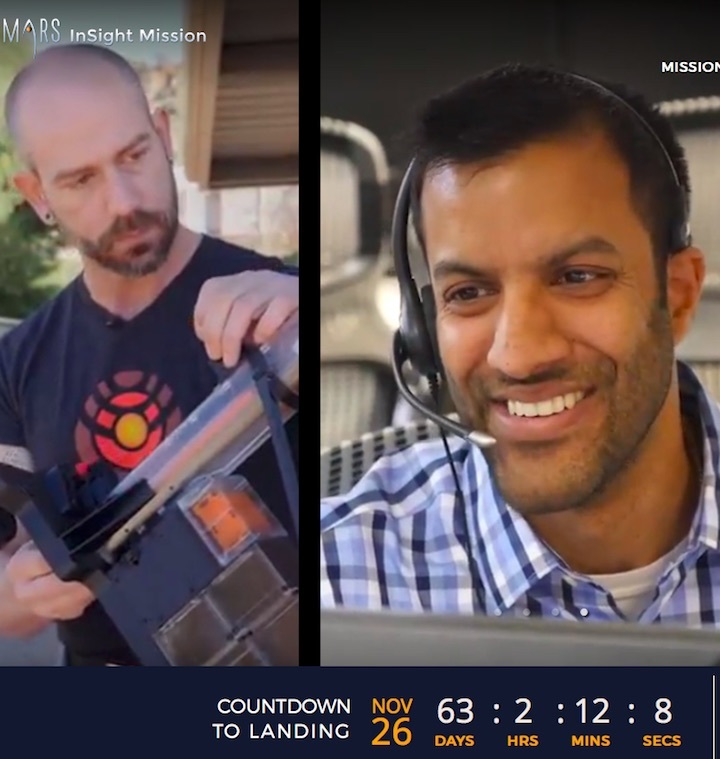
A new series of videos introduces some of the people leading NASA's InSight, the agency's next mission to Mars.
"Behind the Spacecraft" profiles the men and women working on the first mission ever dedicated to studying Mars' deep interior. The InSight spacecraft is on its way to a Nov. 26 landing on the Red Planet. All the videos are available today and will be spotlighted on social media each week over the next three months.
After landing on Mars, InSight will use a seismometer to detect quakes inside the planet, and place a probe up to 16 feet (5 meters) under the surface to measure the heat escaping from its depths. InSight stands for Interior Exploration Using Seismic Investigations, Geodesy and Heat Transport.
InSight is an international mission that includes participation from several European agencies and institutions, including France's National Center for Space Studies (CNES) and the German Aerospace Center (DLR). Important figures from these collaborators are also profiled in the "Behind the Spacecraft" series.
Two videos also focus on Mars Cube One, or MarCO, the first pair of CubeSats to attempt the journey to Mars. These "Meet MarCO" videos share the personalities of young engineers working to demonstrate how miniaturized spacecraft technology can be used on future missions. MarCO is a unique, standalone mission of its own, unrelated to the InSight mission's success.
The entire video series was produced by NASA 360 at the National Institute of Aerospace in collaboration with the agency’s Langley Research Center in Hampton, Virginia.
Quelle: NASA
---
Update: 26.10.2018
.
NASA's InSight Will Study Mars While Standing Still
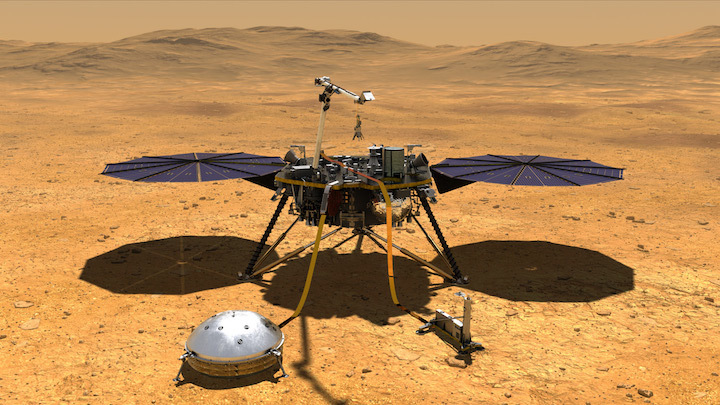
This artist's concept depicts NASA's InSight lander after it has deployed its instruments on the Martian surface. Image Credit:NASA/JPL-Caltech
You don't need wheels to explore Mars.
After touching down in November, NASA's InSight spacecraft will spread its solar panels, unfold a robotic arm ... and stay put. Unlike the space agency's rovers, InSight is a lander designed to study an entire planet from just one spot.
This sedentary science allows InSight to detect geophysical signals deep below the Martian surface, including marsquakes and heat. Scientists will also be able to track radio signals from the stationary spacecraft, which vary based on the wobble in Mars' rotation. Understanding this wobble could help solve the mystery of whether the planet's core is solid.
Here are five things to know about how InSight conducts its science.
1. InSight Can Measure Quakes Anywhere on the Planet
Quakes on Earth are usually detected using networks of seismometers. InSight has only one - called SEIS (Seismic Experiment for Interior Structure) - so its science team will use some creative measurements to analyze seismic waves as they occur anywhere on the planet.
SEIS will measure seismic waves from marsquakes and meteorite strikes as they move through Mars. The speed of those waves changes depending on the material they're traveling through, helping scientists deduce what the planet's interior is made of.
Seismic waves come in a surprising number of flavors. Some vibrate across a planet's surface, while others ricochet off its center. They also move at different speeds. Seismologists can use each type as a tool to triangulate where and when a seismic event has happened.
This means InSight could have landed anywhere on Mars and, without moving, gathered the same kind of science.
2. InSight's Seismometer Needs Peace and Quiet
Seismometers are touchy by nature. They need to be isolated from "noise" in order to measure seismic waves accurately.
SEIS is sensitive enough to detect vibrations smaller than the width of a hydrogen atom. It will be the first seismometer ever set on the Martian surface, where it will be thousands of times more accurate than seismometers that sat atop the Viking landers.
To take advantage of this exquisite sensitivity, engineers have given SEIS a shell: a wind-and-thermal shield that InSight's arm will place over the seismometer. This protective dome presses down when wind blows over it; a Mylar-and-chainmail skirt keeps wind from blowing in. It also gives SEIS a cozy place to hide away from Mars' intense temperature swings, which can create minute changes in the instrument's springs and electronics.
3. InSight Has a Self-Hammering Nail
Have you ever tried to hammer a nail? Then you know holding it steady is key. InSight carries a nail that also needs to be held steady.
This unique instrument, called HP3 (Heat Flow and Physical Properties Package), holds a spike attached to a long tether. A mechanism inside the spike will hammer it up to 16 feet (5 meters) underground, dragging out the tether, which is embedded with heat sensors.
At that depth, it can detect heat trapped inside Mars since the planet first formed. That heat shaped the surface with volcanoes, mountain ranges and valleys. It may even have determined where rivers ran early in Mars' history.
4. InSight Can Land in a Safe Spot
Because InSight needs stillness - and because it can collect seismic and heat data from anywhere on the planet - the spacecraft is free to land in the safest location possible.
InSight's team selected a location on Mars' equator called Elysium Planitia - as flat and boring a spot as any on Mars. That makes landing just a bit easier, as there's less to crash into, fewer rocks to land on and lots of sunlight to power the spacecraft. The fact that InSight doesn't use much power and should have plenty of sunlight at Mars' equator means it can provide lots of data for scientists to study.
5. InSight Can Measure Mars' Wobble
InSight has two X-band antennas on its deck that make up a third instrument, called RISE (Rotation and Interior Structure Experiment). Radio signals from RISE will be measured over months, maybe even years, to study the tiny "wobble" in the rotation of the planet. That wobble is a sign of whether Mars' core is liquid or solid - a trait that could also shed light on the planet's thin magnetic field.
Collecting detailed data on this wobble hasn't happened since Mars Pathfinder's three-month mission in 1997 (although the Opportunity rover made a few measurements in 2011 while it remained still, waiting out the winter). Every time a stationary spacecraft sends radio signals from Mars, it can help scientists improve their measurements.
About InSight
JPL manages InSight for NASA's Science Mission Directorate. InSight is part of NASA's Discovery Program, managed by the agency's Marshall Space Flight Center in Huntsville, Alabama. Lockheed Martin Space in Denver built the InSight spacecraft, including its cruise stage and lander, and supports spacecraft operations for the mission.
A number of European partners, including France's Centre National d'Études Spatiales (CNES) and the German Aerospace Center (DLR), support the InSight mission. CNES provided the Seismic Experiment for Interior Structure (SEIS) instrument, with significant contributions from the Max Planck Institute for Solar System Research (MPS) in Germany, the Swiss Institute of Technology (ETH) in Switzerland, Imperial College and Oxford University in the United Kingdom, and JPL. DLR provided the Heat Flow and Physical Properties Package (HP3) instrument.

